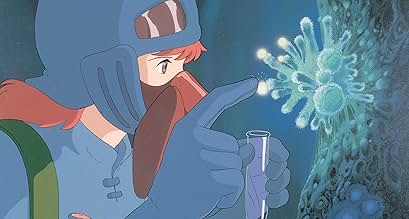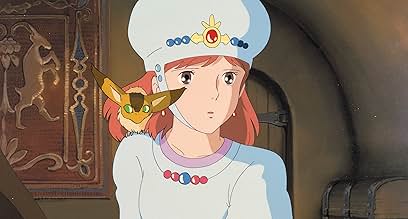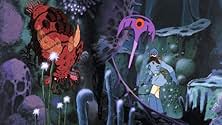La princesse Nausicaä, une guerrière pacifiste, lutte désespérément pour empêcher deux nations belliqueuses de se détruire mutuellement, avant que leurs affrontements ne mettent en péril la ... Tout lireLa princesse Nausicaä, une guerrière pacifiste, lutte désespérément pour empêcher deux nations belliqueuses de se détruire mutuellement, avant que leurs affrontements ne mettent en péril la planète déjà mourante.La princesse Nausicaä, une guerrière pacifiste, lutte désespérément pour empêcher deux nations belliqueuses de se détruire mutuellement, avant que leurs affrontements ne mettent en péril la planète déjà mourante.
- Réalisation
- Scénario
- Casting principal
- Récompenses
- 3 victoires et 1 nomination au total
- Nausicaä
- (voix)
- Jihl
- (voix)
- …
- Oh-Baba
- (voix)
- Mito
- (voix)
- Goru
- (voix)
- Gikkuri
- (voix)
- Niga
- (voix)
- Teto
- (voix)
- …
- Girl A
- (voix)
- Girl B
- (voix)
- Boy A
- (voix)
- Asbel
- (voix)
- Rastel
- (voix)
- Mayor of Pejite
- (voix)
- (as Makoto Terada)
Avis à la une
Without revealing too much of the plot, it takes us through the life of Nausicaa, a princess of a small village, and her struggles to stop warring nations from destroying an important source that can save the planet. The planet has already gone through a major destruction that nearly wiped out humanity, and their are large insects called ohmu, that guard the source that is spreading through the world.
Miyazaki introduces an empowerment of female characters in his animes, such as Princess Mononoke, Kiki's Delivery Service, and his most recent, Howl's Moving Castle (Hauru no ugoku shiro). The characters are done with style and care, and, in Nausicaa, there is no exception.
It amazes me that this film created some controversy when released, being banned in Poland because of it's depiction of an ecological disaster. Though the movie is obviously fantasy, it turns out that some may consider it a touchy subject. I didn't find any offense whatsoever with anything the movie showed, just a futuristic disaster no doubt caused by man.
Combining fantasy and science-fiction, Nausicaa is nice to look at. It certainly shows it's age when compared to some newer animes, not having the help from high-end computers. Considering it was done in the 80's, Miyazaki's production team did a great job. Little details, backgrounds, gadgets, & animals are drawn slightly better then some Japanese animes from that time.
Keep in mind that my review is based on the Disney release (Feb 2005). It's cleaned up, unedited, with new voices from well known actors that sound great (but I still prefer subtitles). Keep far away from the old version 'Warriors of the Wind', which chops off more then half-hour from the movie.
9 out of 10
Although the incredible "Princess Mononoke" later upstaged this early work in terms of art and detail, in many ways I still prefer "Nausicaa". Its imaginitive and well-conceived world puts me in mind of Dune with its feuding factions, its giant creatures, and its strong ecological message. Even with a rather long running time, the story moves very briskly (boiled down as it was from a very lengthy manga series). The music deserves special mention, as well, as it is a large step up from the electronic pop stylings of most anime.
If you can get your hands on a copy of the original version, you'll find it more than worth the effort.
Nausicaä, which is based on Miyazaki's gargantuan Manga series, is set in the distant future, after fires destroyed much of the earth. The world is being consumed by the Sea of Decay, a toxic forest that spreads through airborne spores and is protected by giant insects called ohmu. The Valley of the Wind is one of the last pure places on earth, and its Princess, Nausicaä, is a strong-willed yet free-spirited young woman seeking to solve the mystery of the Sea of Decay. A nearby nation, which claims to have harnessed the power that allowed humans to rule the earth a thousand years before, takes over after a plane carrying a mysterious living cargo crashes in the valley. What follows in the film is a struggle, not of good versus evil, but of man versus nature. The story is complex, as is its message, and Miyazaki has ingeniously spun deep complexities into the animated characters: what look like foes may not be, and what look like friends may be a bit more dangerous.
The animation is colorful, sweeping, expansive, and beautiful, as are the plot and characters. There is an immediacy to the story that makes a big emotional impact and makes us question how we handle our position in nature. As one of the characters in the film asks, have humans become but a tribe destined to be swallowed by the Sea of Decay? It is ultimately a film about compassion in the face of violence and war, which is what makes it so different from Western features.
Disney's recent DVD release is excellent. The film can be watched either in the original Japanese audio or Pixar's dub with Patrick Stewart and Uma Thurman, and there are separate subtitles for each language track--a literal one (hallelujah!) for the Japanese track, and a more closed-captions style set for the English track. The film is so stunning in the Japanese that I have never considered watching the dub, though a fellow film buff has said that it is "not so bad." After this film was released in the US in the 1980s in a completely mangled version called Warriors of the Wind, Miyazaki suspended all US rights of all his other films until the distributor would honor the stipulation that they be released without any editing. The fact that Disney, which is known for watering down nearly everything it touches, has done this with such a non-Western-style movie is amazing.
Le saviez-vous
- AnecdotesWhen Nausicaä was first released as an English dub in the U.S. in 1985 it was drastically cut down to 1 hour and 35 minutes and titled Warriors of the Wind. Writer and Director Hayao Miyazaki was still so upset by the truncated "Warriors of the Wind" version of Nausicaä that when Harvey Weinstein approached him to discuss the distribution to his following film Princesse Mononoké (1997) and insisted on a similar heavily cut version of the movie, Miyazaki angrily left the meeting. Several days later, Studio Ghibli producer Toshio Suzuki sent a katana sword to Weinstein's office with "NO CUTS" embedded into its blade. The movie was later released in the U.S. in its uncut version. During a later interview, Miyazaki commented on the incident by smiling and stating, "I defeated him." Nausicaä was his only film to suffer heavy editing on first release. In 1995 the US rights returned to Miyazaki and he made a distribution deal with Disney. In 2003 a new English dub with Patrick Stewart and Uma Thurman was released in the uncut 117 minute (1hr 57min) version. - James LaPierre WUD Films
- GaffesDuring the climactic battle scene, the design of Oh-Baba's headband changes several times. It sometimes has gold beads instead of gold-circled turquoise beads on the end-pieces, and alternately terminates with a single or a double line of cord.
- Citations
Nausicaä: Every one of us relies on water from the wells, because mankind has polluted all the lakes and rivers. but do you know why the well water is pure? It's because the trees of the wastelands purify it! And you plan to burn the trees down? You must not burn down the toxic jungle! You should have left the giant warrior beneath the earth!... Asbel, tell them how the jungle evolved and how the insects are gaurding it so we won't pollute the earth again. Asbel please!
- Crédits fousAs the credits roll we see life returning to normal in the valley: Kushana, Kurotowa and the Tolmekian fleet leave peacefully, after Nausicaä has unheard words for Kushana. The denizens of the Valley of the Wind replant trees in the burned-down forest. Lord Yupa and Asbel ride Yupa's beasts to the Toxic Jungle and explore it. When the text "The End" appears on screen we see Nausicaa's discarded helmet in the forest, alongside a green, non-Toxic Jungle sapling.
- Versions alternativesIn the original Japanese version of the film, a World Wildlife logo praising the film is displayed at the beginning. For the US release from Disney, this logo was replaced with a typical Studio Ghibli logo.
- ConnexionsEdited into Tales of the Valley of the Wind (2009)
- Bandes originalesKaze no Tani no Naushika (Symbolic Theme Song)
Lyrics by Takashi Matsumoto
Music by Haruomi Hosono
Arranged by Mitsuo Hagita
Vocals by Narumi Yasuda (Tokuma Japan)
Meilleurs choix
Détails
Box-office
- Budget
- 1 000 000 $US (estimé)
- Montant brut aux États-Unis et au Canada
- 495 770 $US
- Montant brut mondial
- 9 012 301 $US
Contribuer à cette page


































